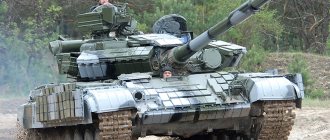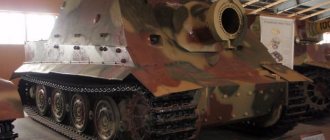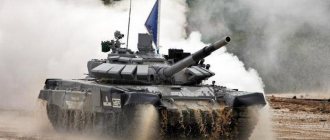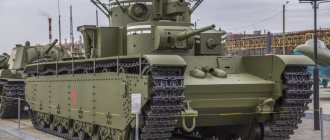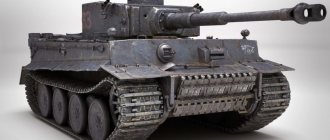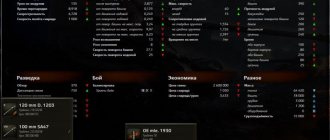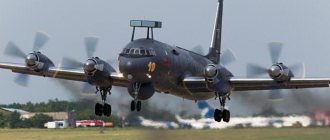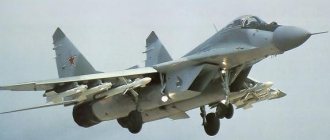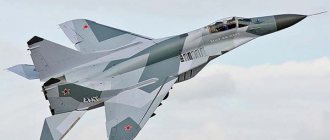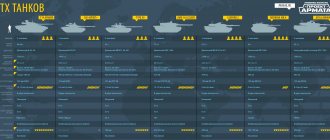"Bulat" is a Ukrainian battle tank, which is a deep modernization of the latest modifications of the Soviet T-64 vehicle. It was developed by the Kharkov Design Bureau named after. A. A. Morozova. The modernization work is carried out by the plant named after. Malysheva. In addition to him, more than two dozen Ukrainian military-industrial enterprises are involved in the modernization program to varying degrees. Compared to previous versions, Bulat has greater firepower, an increased level of protection and greater maneuverability. This article will discuss the tactical and technical characteristics (TTX) of the T-64 Bulat tank, as well as the history of its creation and production.
Prerequisites for creation
After the collapse of the USSR, from 1991 to 1999, the Kharkov Mechanical Engineering Design Bureau (KMDB) developed several tank modernization projects. The goal of the work was to increase the tactical and technical characteristics of the vehicle to the level of the T-84U model through the installation of the Irtysh unified fire control system (FCS), the Knife dynamic protection (DZ) and a number of other measures.
On August 24, 1999, at the parade dedicated to the Independence Day of Ukraine, the first prototype of the Bulat tank was shown. It received the working name “Object 447AM-1”. At the end of 2003, the Ukrainian government allocated 40 million hryvnia for the modernization of old T-64 tanks. Plant named after Malysheva immediately set about solving the problem. Initially, the modernization project involved the modification of 400 T-64B/BV models.
Tanks of Ukraine: present and future
An interview with director Kharkovsky appeared on the Ukrainian Internet resource “Apostrophe,” seemingly revealing the state and prospects of Ukrainian tank building. The interview talks about the “new products” of the Ukrainian military-industrial complex, the T-64BM “Bulat” tanks, the T-84U “Oplot” and the promising “Nota” tank. It should be noted that the interview is given by the director of the plant, who is far from developing tanks and their characteristics, like any director, he has only one task: to mass produce what he is ordered to do. The development of the tank is carried out by the Design Bureau named after. Morozov, and it determines the appearance, characteristics of tanks and prospects for their development. Therefore, the opinion of the plant director must be treated quite carefully; he simply does not know or understand many things, and is wishful thinking.
The article describes the state and prospects of Ukrainian tank building in rosy tones. At one time I had to develop prototypes of today's Ukrainian tanks, and I have a good idea of what their characteristics and capabilities are. I can immediately say that these tanks had an excellent Soviet past, now the Ukrainian present is deplorable, and the future will be the same.
The article gives high praise to the Ukrainian T-84 tank, the modernized Soviet T-64BM Bulat tank, the “most advanced” T-84U Oplot tank and the promising Nota tank.
How the T-84 tank appeared
Let's look at what these tanks are.
The T-84 tank is a complete copy of the Soviet production tank T-80UD. This is the latest modification of the T-80U tank, which was put into service in 1984. In accordance with the draft government decree prepared in 1990, all tank factories were supposed to gradually switch to the production of this tank, but the Union collapsed and this was not implemented. The tank was mass-produced at the plant named after. Malyshev until 1992. The T-84 tank appeared in 1996 when Ukraine concluded a contract with Pakistan for the supply of 320 tanks. Under this contract, the T-80UD was renamed due to the fact that the task was set to transfer the entire Russian configuration of the tank to Ukrainian. This problem was solved, and deliveries to Pakistan were mainly made with Ukrainian equipment.
The T-80UD tank had a 6TDF diesel engine with a power of 1000 hp, a 2A46M cannon, an Irtysh gunner’s sighting system, a Reflex guided weapon system, an Agat-S commander’s sighting system, and a closed Utes anti-aircraft gun.
Ukraine was not able to independently produce this tank; most of the components were supplied from Russia. This was especially true for the gun and sighting systems, without which the tank could not be produced. Several accidents helped to implement a closed cycle of tank production in Ukraine.
In 1990, in connection with the preparation of mass production of the T-80UD tank and the expansion of the production of components for it, it was decided to launch the production of the Irtysh sighting system, the laser guidance channel of the Reflex missile and the Agat-S sighting system in addition to the Vologda optical-mechanical plant at the Cherkasy Optical-Mechanical Plant and all documentation was transferred to this plant. So in Ukraine, before the collapse of the Union, there appeared its own production of the most advanced tank sighting systems at that time, which Ukraine was not able to independently develop and produce.
No one has ever been involved in the development and production of guns of any caliber in Ukraine, but the KMDB had a complete set of documentation for the 2A46M gun. The breech of the gun was reproduced by the plant named after. Malysheva. To produce barrels, special equipment and technology were needed, which did not exist. They found equipment at several Ukrainian enterprises and instructed them to organize the production of barrels. It was impossible to do this without technology; the most interesting thing is that the technology was transferred from the Perm gun factory. Moreover, specialists from this plant were sent to Ukraine for a special reward, and with their help, the production of barrels was organized, now for the Ukrainian KBA-3 cannon. So Russia, with its own hands, raised a competitor in the production of guns in Ukraine.
There was no documentation for the Reflex missile in Ukraine; Yuzhnoye Design Bureau attempted to develop such a missile, but they were working on very large missiles and could not develop such a “small” one. This work was entrusted to the Kyiv design bureau "Luch", which previously took part in the development of aircraft missiles. Having already had documentation and production of the laser guidance channel for the Reflex missile, they tried to replicate this missile for more than ten years and eventually developed and put into production the Combat missile, which in its characteristics corresponds to the Reflex missile. This missile became the prototype for a whole family of missiles produced in Ukraine for various types of military equipment.
All electronics, most of the documentation for which was also available, were reproduced at Kharkov enterprises that produced electronics for the Soviet rocket and space complex. The hydraulic drive of the gun stabilizer was reproduced at the FED plant, which had excellent technology for the production of hydraulic machines for aviation.
As a result, the entire configuration of the tank was reproduced and put into production using money from the Pakistani contract. Thus, they managed to replicate the Soviet T-80UD tank and pass it off as a new Ukrainian development of the T-84 tank.
Upgraded T-64BV tank
In Ukraine, in the late 90s, a project was implemented to modernize the Soviet T-64BV tank, mass-produced in 1976-1984, which received the T-64BM Bulat index.
The modernization consisted of bringing its characteristics to the level of the T-84, with the installation of the gunner's sighting system "Irtysh", the commander's sighting system "Agat-S", the replacement of the "Cobra" guided weapon system with "Reflex", which had already received Ukrainian names and indices, a set dynamic protection "Knife", an upgraded night sight for the gunner "Buran", installation of a 5TDFM engine with a power of 850 hp. or 6TD-1 with a power of 1000 hp. In the early 2000s, 10 such tanks were modernized; the tank was never put into mass production. With the start of the war in Donbass, a small batch of T-64BV tanks was modernized, but it was no longer possible to modernize the tanks en masse due to the collapse of tank production and lack of funding.
Tank T-84U "Oplot"
It’s as if the new Ukrainian tank T-84U “Oplot” was developed in 2011 as a further development of the T-84 tank.
It was distinguished by the installation of a 6TD-2E engine with a power of 1200 hp, an auxiliary diesel power unit with a power of 10 kW, a welded turret, dynamic protection “Duplet”, a gunner’s thermal imaging sight with imported components, a commander’s panoramic sight with a laser rangefinder and a thermal imaging channel, a navigation system with a tablet displaying information based on GPS/GLONASS satellite navigation signals, an optical-electronic countermeasures system based on the Soviet Shtora system. In total, one T-84U Oplot tank was produced. Serial production could not be organized due to the collapse of industry and lack of funding. In 2011, a contract was signed with Thailand for the supply of 49 of these tanks, which was completed with difficulty only in 2018.
The upgraded T-64 BM "Bulat" and T-84 tanks are at the level of the Russian T-72 B3 tank in terms of firepower and mobility with the Sosna U gunner's sighting system, the Agat-S commander's sighting system and a 1000 hp engine. ., as well as at the T-90 level with the Irtysh-Reflex gunner’s sighting system, the Agat-S commander’s sighting system and a 1000 hp engine.
The T-84U “Oplot” tank is at the level of the T-90SM tank with the “Sosna U” gunner’s sighting system, the “Hawkeye” commander’s panorama and a 1130 hp engine.
Myths about the Nota tank
Regarding the promising Ukrainian tank “Nota”, the plant director is telling some idle speculation, without knowing or understanding the essence of the problem.
He says that the project for the Nota tank was developed back in the Soviet Union with an uninhabited turret, the drawings were transferred to Moscow and the tank was repeated there, making the Armata. It’s hard to even come up with such nonsense; fairy tales are purely in the Ukrainian style. I am a participant in the development of the last Soviet tank “Boxer”, which has nothing to do with “Nota”. Work on the Boxer tank was stopped in 1991 due to the collapse of the Union and the impossibility of carrying out such complex and expensive developments in Ukraine. It was an experimental design work with the production of several prototypes, but the design bureau ended up in another country and the work was stopped.
The Boxer tank had a classic layout with a manned turret and a semi-extended gun. The concept of the tank was well known in the Ministry of Defense Industry, its project was considered and defended there with the participation of representatives of the Ministry of Defense, Kubinka, VNIITM, there was no secret for specialists, besides, developments on many components and systems of the tank were carried out in Russia.
The documentation for the tank was not transferred to Moscow until 1995, at which time I was still working in the design bureau. Perhaps, during the implementation of the Pakistani contract, something could have been offered for assistance in its implementation, but there was no particular need for this, too much time had passed. After the collapse of the Union, the project of the promising tank “Object 195” was developed at UVZ in the early 90s, it used many ideas, components and systems of the Boxer tank, a 152-mm semi-extended gun, sighting systems, TIUS and a number of other systems developed for the tank "Boxer" by Russian enterprises. The difference was the uninhabited turret and the placement of the crew in a capsule in the tank's hull. In 2009, this project was abandoned and the Armata project was launched with a different concept.
Mythical stories that a new promising tank is being developed in Ukraine can only be taken as an anecdote. There are neither resources nor opportunities for this. The tank is being developed not only by the tank design bureau, but by a host of related companies, without which it cannot be created. There are no such related companies in Ukraine today, there is global devastation in science and industry, what tanks are there!
In the late 90s, the KMDB carried out exploratory research work “Nota” to search for the concept of the tank of the future and nothing more. One of the participants in this project already wrote on the Internet that they drew pictures of tanks, no one seriously worked on them, much less developed the design of the tank and all its components and systems. This is done in any design bureau and even by amateurs, it is of little use. This work has long since ended in nothing, tanks are created by teams of specialists in various industries, and this is only possible in a strong and rich state, and not in a poor and collapsing Ukraine.
Prospects for Ukrainian tank building
The tank building school at KMDB is still preserved, but it went to the wrong state.
Without serious economic, scientific and industrial power, no one needs this. In Soviet times, masterpieces of tank building were created there. In the Soviet era in the 90s, when industry had not yet collapsed, it was possible to maintain that level and modernize tanks, achieving good performance. With today's devastation, it is impossible to even reproduce what was, and in the near future it will be lost. For now, it is still possible to modernize previously produced tanks, bringing them to the level of the T-84 (T-80UD), but this will not last long. Soon there will be no one to produce the components.
The T-84BM "Bulat" and T-84U "Oplot" tanks are not in the Ukrainian army for two reasons: firstly, it is no longer possible to establish their mass production due to the collapse of industry; secondly, Ukraine does not need such complex tanks with high performance and cost in military operations in the Donbass, which is why they are not in demand. No one will let Ukraine into the foreign arms market now; no one needs a competitor there. In this regard, the prospects for Ukrainian tank building are very dismal.
Beginning of work
In 2004, the T-64BM was put into service, and the Ukrainian Ministry of Defense ordered 85 of these tanks. The production of the first production model took about eight months and 500 thousand dollars. In the same year, the Malyshev plant began fulfilling the first contract for the modernization of 17 tanks, the total cost of which was $8 million. By the end of 2008, two more batches were released. As a result, by the beginning of 2009, 56 units of the Bulat tank were produced.
In 2009, a contract was signed for the modernization of another 29 vehicles. The first 10 of them were ready by October 2010 and were intended for training. All 10 vehicles were delivered without dynamic protection. The next 10 copies were manufactured by December 2011. At the end of the same month they were transferred to the first separate tank brigade. These ten tanks also did not have an active protection kit. And finally, the last 9 vehicles were sent to the first tank brigade only in March 2014. However, dynamic protection kits for these vehicles were ordered only in July of the same year. At that time, the cost of the modernized Bulat tank was about 15 million hryvnia.
BM "Oplot"
The main hope is that it is far superior to all other Ukrainian tanks in service in 2022, because at least it is younger and more promising. The production is carried out by the ZTM plant named after Malyshev. The heavy tank entered production in 2008 and entered service the following year. At the moment, their number has increased to 50 units. The 125 mm KBA-3 gun was chosen as the main weapon for Oplot, which became a full-fledged copy of the Soviet 2A46M-1. The ammunition load includes 46 shells that are always ready for loading. It has its own active protection, this is “Varta”, but if you look at which tanks in Ukraine’s arsenal have the same, you won’t find an answer. The forehead is rolled up with armor 65 cm thick, the body 50 cm thick.
- Weight: 51 t
- Gun: 125 mm (KBA-3)
- Power: 1200 hp
- Speed: 70 km/h
- Power reserve: 500 km
Tank repair
Ukrainian tanks: Bulat, Oplot, T-72 and others were heavily damaged during the ATO. Several vehicles were destroyed and about ten were damaged. In December 2014, the repaired tanks were transferred to the Ukrainian Armed Forces at the Chuguevsky training ground. In total, by June 2022, the Kharkov plant named after. Malysheva repaired and returned to service 50 T-64BM vehicles damaged during the battles in the east of the country. Many Ukrainian enterprises took part in the development, modernization and repair of the described tank. The most important of them was the Kharkov Armored Plant (KhBTZ). Military products, and in particular tanks that were modernized at Kharkov enterprises, received an increased service life of 15 years. In addition, the resource has increased by 11 thousand kilometers. The time has come to begin describing the design of the Bulat tank.
T-84U "Oplot"
The original 84 was designed and built at the Kharkov plant. Over the entire period, very few units of such equipment were produced. During the improvement, the combat vehicle received a welded-rolled turret, the armor was multi-layered and reliable. To date, no more than 5 units of these modernized versions have been made Ukrainian tanks The Knife DZ is responsible for dynamic protection.
- Weight: 47.5 t
- Gun: 125 mm (2A46M-1)
- Power: 1200 hp
- Speed: 70 km/h
- Power reserve: 450 km
Fire control system and aiming devices
The Bulat fire control system significantly increases the accuracy of fire compared to a similar system in the T-64B tank. This is achieved by stabilizing the field of view, as well as automatically entering aiming and lead angles. In addition, the time required for aiming in the dark has been reduced significantly. The effective firing range of the Bulat tank, compared to the Soviet version, has also increased: from 2 to 2.5 km during the day and from 0.6 to 1.5 km at night.
The Irtysh fire control system installed on this tank includes:
- Sighting system 1A43U "Ros". Designed for aiming guns, including coaxial machine guns and ATGMs (anti-tank guided missiles). Consists of the gunner's day sight "Promin" and a ballistic tank computer model 1B528-1. The magnification of the Promin sight is 2.7-12x. It is equipped with independent stabilization in two planes, a laser rangefinder, as well as a semi-active control channel for the Kombat ATGM.
- Night guidance complex "Buran-E". Allows you to double the fire efficiency and reduce the preparation time for a shot by 2-3 times. This is achieved by replacing the mechanical connection between the head mirror and the gun with an electrical one, introducing stabilization of the field of view, as well as automatically entering aiming and lead angles. The design provides for the possibility of installing a Buran-Katrin model thermal imager on it, however, the thermal imager is not included in the standard equipment for financial reasons.
- Main armament stabilizer model 2E42M. Allows you to double your aiming accuracy. The stabilizer was developed by employees of the Kyiv research institute "Kvant". Production is established at the Kharkov machine-building plant.
- Sighting and observation complex "Agat". Thanks to vertical stabilization, it provides duplication of fire from a cannon and a machine gun coaxial, day and night.
- Sight and pointing drive of an anti-aircraft gun.
- Guided weapon complex model TAKO-621. Allows firing from the Kombat ATGM from a distance of up to 5 kilometers.
In the future, it is planned to replace the Agat sighting system with a more modern Agat-SM, which includes a laser rangefinder and a lateral lead input device. The sights with which the tank is equipped are modernized versions of the Soviet complexes and devices “Buran”, “Agat” and “Irtysh”, distinguished by new components that significantly increase the capabilities of the devices. All devices and sights are mass-produced at two Ukrainian enterprises: the Cherkassy research and production complex “Fotopribor”, as well as the Izyum Instrument-Making Plant.
T-64BV
This model was introduced into Ukrainian tanks in 1985, a modernized version of the original. The only changes concerned the Kontakt-1 dynamic protection, as well as improvements to the armor on the hull. The Ukrainian tank is equipped with the 9M112 Cobra missile system and a laser rangefinder, which is characterized by increased accuracy in calculating the distance to the target.
- Weight: 39 t
- Gun: 125 mm (2A46M-2)
- Power: 700 hp
- Speed: 60 km/h
- Power reserve: 600 km
Armament
The main armament of the combat vehicle is a smoothbore gun of the KBAZ model or 2A46M-1, with a caliber of 125 millimeters. It is equipped with a quick-release barrel, which can be easily replaced in the field without having to dismantle the tank's turret. The turret is equipped with an electric drive, and the gun is equipped with a hydraulic drive. The upgraded turret rotates twice as fast – 40 degrees per second. In case of emergency situations, the gun and turret are equipped with backup mechanical drives.
The gun's ammunition includes 36 separate-case-loaded shells, 28 of which are placed directly in the loading mechanism. The Bulat tank can fire cumulative, armor-piercing sub-caliber, high-explosive fragmentation shells and Kombat ATGMs, with a laser beam control system.
In a minute, the tank is capable of firing 8 shots from the main gun. Loading one shot takes from 7 to 12.5 seconds. This speed is achieved through automatic charging and tandem dispensing in one cycle. The spent cartridge is removed using an automatic catch and tray system.
Protection
Thanks to the installation of additional armor for the hull and bottom, the designers were able to significantly increase the level of protection of the Bulat tank. Additional protection (AP) made it possible to increase the tank's level of protection against modern armor-piercing and cumulative sub-caliber projectiles with a minimal increase in vehicle weight. The DZ kit included passive (overhead) armor protection and built-in dynamic armor protection (DZ). The VDZ includes a nose module and side screens installed on the tank hull, modular sections located along the entire perimeter of the side and front sections of the turret, as well as containers installed on the roof of the turret.
In total, the additional protection kit weighs 3.5 tons. The crew can install the DS kit on their tank in 6 hours. During operation of the machine, the remote control elements do not require special maintenance.
The VDZ of the “Knife” model, unlike the “Relic” and “Duplet” models, does not protect the tank from tandem cumulative shells. It reduces the penetration level of sub-caliber armor-piercing ammunition by 20%, and cumulative ammunition by 40%. The principle of operation of the “Knife” system is that it cuts the ammunition into several parts with cumulative jets. However, in practice, many Ukrainian Bulat tanks are equipped with the previous Soviet Kontakt-1 system, which cannot affect sub-caliber armor-piercing shells, but is better able to resist cumulative ammunition, reducing their penetration rate by 50-80%. Many modules of the Contact-1 system may not work at the right time, due to the fact that their service life has long expired.
To protect tank crews in the event of a fire, a fast-acting fire protection system is installed inside the fighting compartment and engine compartment, which ensures automatic fire extinguishing within 150 ms.
Motor
The tank is equipped with a 5-cylinder diesel engine 5TDFM, the volume of which is 13.6 liters and the power is 850 horsepower. A two-stroke engine is multi-fuel, that is, in addition to diesel fuel, it can run on kerosene, gasoline, or a mixture of them in any proportion. The power plant is equipped with supercharging, direct fuel injection and direct-flow purge. The cylinders are located horizontally. Compared to the old 5TDF engine, which was equipped with the T-64 tank, the new one has 21.4% more power, with the same dimensions (1413/955/581 mm) and weight (1.04 tons).
The modernized engine was developed by the Kharkov Engine Design Bureau. It is not only more powerful, but also more reliable than its predecessor. To install a new engine on the Bulat tank, the designers had to replace the standard air cleaner and modify the exhaust system. They also foresaw the prospect of installing an even more powerful engine model 6TD-1 (1000 hp) on the tank. The fuel reserve is 1270 liters, 730 of which are in internal tanks and 540 in external tanks. Additional barrels hold another 370 liters.
